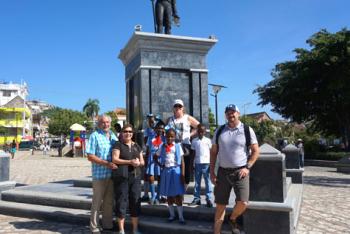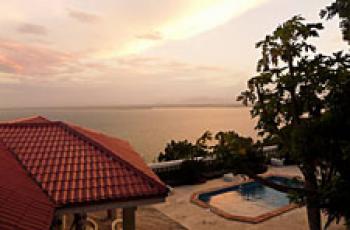A visit to Haiti
This item appears on page 28 of the July 2018 issue.
My family and I had been to a dozen Caribbean nations. We were thinking about Haiti but were unable to decide how best to have a positive impact on its people. There is no shortage of religious and charitable organizations operating there, but just sending one of them some money seemed hollow to us. We wanted to see, feel and touch the country and, yet, travel in relative comfort.
As a place to base, we chose Cap-Haïtien on the north coast because it hadn’t been impacted as much by the 2010 earthquake or subsequent hurricanes, so it would represent a more “normal” Haiti.
Initially, we had planned on staying at a boutique hotel on the waterfront, near restaurants, but after months of emails we were unable to get a price quote.
We then selected Habitation Jouissant (202, Habitation Jouissant, Cap-Haïtien, Haiti; phone +509 3124 2400, www.habitation jouissant.com), located on a hillside above the traffic and noise of the busy city.
I emailed Youri Pierre (youri@habitationjouissant.com) and was quoted $179 per room per night for their premium suites overlooking the pool and the sea. Breakfast, good Wi-Fi and an airport-hotel shuttle was included. We stayed there six nights, Dec. 5-11, 2017. (This fantastic, family-owned boutique hotel was planning to close for a year to add about 80 more rooms.)
The shuttle met us at the airport. The driver remained in the SUV while a dozen young boys grabbed our bags. Each one carried a bag for a few feet and handed it to another until they reached the shuttle. Each one then held out a hand for a tip, claiming, “I am finished helping you.” We picked the biggest boy and handed him $10, leaving it to him to distribute.
The drive from the airport to the hotel was the most depressing stretch of road in any city we’ve been to, including places in Yemen. Trash was piled everywhere, and at some intersections the trash was so high that a lane had been closed. The waterfront had some of the worst areas of trash, with a huge burning pile near the foot of a bridge.
Yes, I got some withering looks from my family, suggesting, “What were you thinking?!” Despite our extensive travels, nothing had prepared us for the squalor in Haiti.
•
Here is some basic information about Haiti for those planning to travel there.
The country’s poverty is extensive and persistent. A $5 tip goes a long way in making a difference! US dollars are widely accepted and easily exchanged for the local currency, the gourde ($1 = HTG65).
Use only bottled water for drinking and brushing teeth. We found the ice in the hotel and restaurants to be safe. Peeled food (such as sweet bananas and guavas) were safe, as was cooked food, from lobster to grilled snapper.
Prestige, the national beer, was good and reasonably priced, but the national rum, Barbancourt, had a medicinal taste. Wine was very expensive, with limited choices.
If you appreciate things like smooth roads, traffic controls and “rules of the road,” Haiti is not the place to drive, yourself; it’s not for the faint of heart. Very few roads were paved, and some so-called potholes were almost drop-offs.
The never-ending throngs of motorbikes (often with two adults and two or three children on one motorbike!), tap taps (brightly painted trucks and buses carrying eight to 12 paying passengers, some of whom are hanging onto the bumpers) and trucks too big for the narrow streets, with little concern for which side of the road is used, all create chaos. We saw hundreds of near-misses.
Now for the good part!
Despite the poverty there, we found Haitians to be polite, friendly and very happy to see real tourists.
Nearly everyone smiled at us, with a hearty “Bonjou” or “Hello.” Schoolchildren surrounded us in the public square to practice their English. A mother introduced her school-uniformed daughter to Patti, saying, “She loves you,” and they began a conversation in English.
People were dressed well, with clean clothes and shiny shoes. They were proud.
•
On the day we arrived, we asked at our hotel about a guide, and they contacted the driver/guide Jean Marc Eugene. His quote was $50 for the four of us for three hours. His English skills were good, as was his insight and knowledge of the country.
He gave us a city tour. After two hours, we asked if he could take us out of the city and along the hillside to view the beaches and clean sea. No problem!
We saw a bit of Labadee and found a beach resort, Cormier Beach Resort Haiti (Route de Labadie; cormierhaiti.com). We would return to it on another day for sand, sun and a terrific Creole lunch. It had a non-guest visitor rate of $5 per person that allowed access to outdoor showers, clean toilets, lounge chairs and umbrellas. Drinks and meals could be purchased in the seaside dining/bar area.
At tour’s end, we tipped Jean Marc $10 and he seemed pleased.
The highlight of northern Haiti was the Citadelle Laferrière in nearby Milot. My son, Bill, and his wife, Jenny, went there on a half-day trip that Jean Marc arranged. They paid $135 per person, including tips. (Patti, 63, and I, 76, opted out because of the amount of climbing and horseback riding required to reach the top. There were no accommodations for those with elderly knees!)
According to Jenny, the horses weren’t very cooperative and the saddles seemed too loose, but she and Bill both said the view was breathtaking, and they were impressed at the amount of reconstruction they saw.
Another day took us out of town to an authentic voodoo experience practiced next to the Catholic church. No photos were allowed, as people stripped down and went into the adjoining water to cleanse. They would write their wishes on a wall and then, often, burn them with a candle flame.
We encountered a local enterprise on the road out. A big pothole was being filled by a group of boys. They had surrounded the site with tires to slow traffic and were soliciting payment from grateful drivers. About every second vehicle offered some small payment.
We spent our last day enjoying the food, swimming pool and rum punch at the hotel while reflecting on our visit.
Haitians with jobs work hard, and it’s even harder for those in the informal economy.
Yes, the electric grid couldn’t meet demand, and lights sometimes flickered. Food had to be delivered daily because of refrigeration issues, and Internet connections were lost.
But Haiti had friendly people and healthy food, we found Haiti’s northern beaches to be clean and safe, and the weather was typical of the Caribbean. Also, the country could use tourism dollars.
TONY LEISNER
Tarpon Springs, FL


